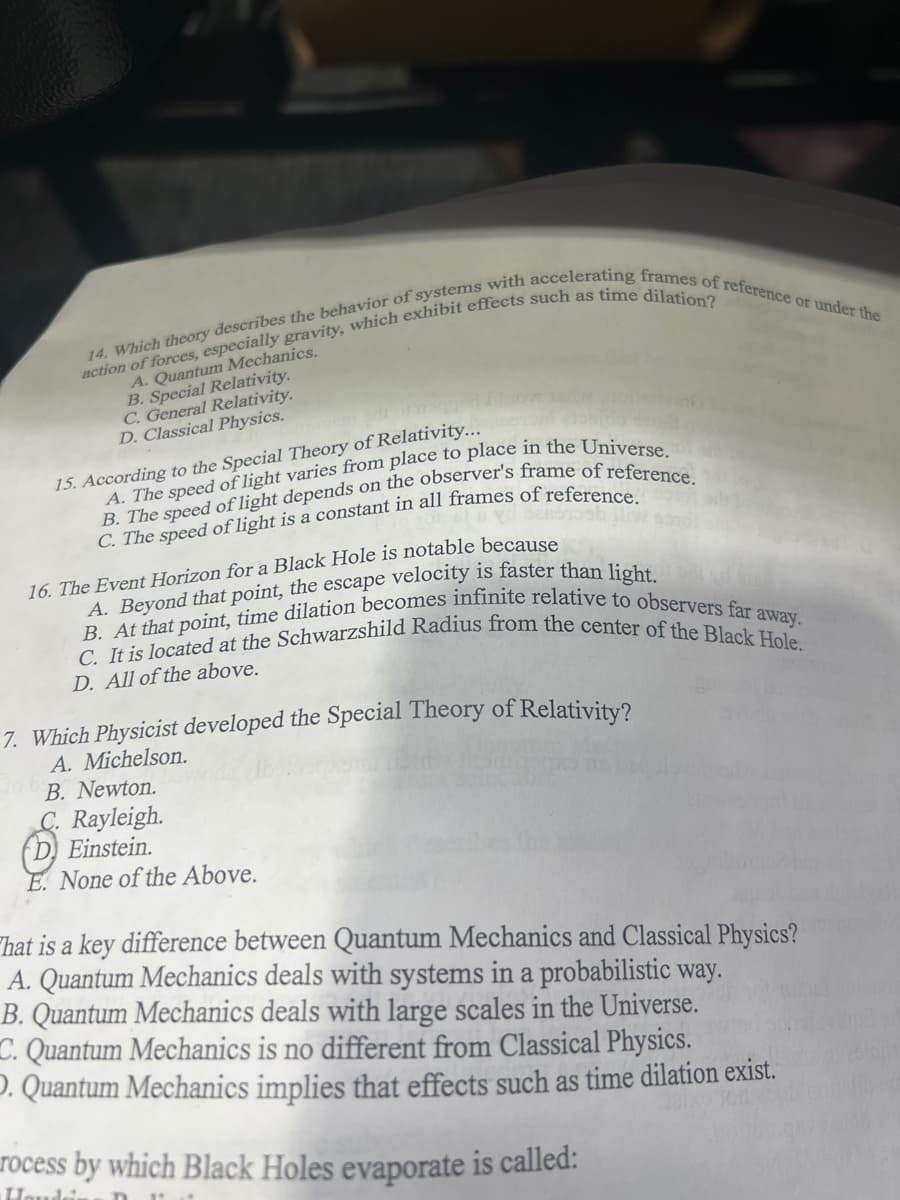14. Which theory describes the behavior of systems with accelerating frames of reference or under the action of forces, especially gravity, which exhibit effects such as time dilation? A. Quantum Mechanics. B. Special Relativity. C. General Relativity. D. Classical Physics. 15. According to the Special Theory of Relativity... A. The speed of light varies from place to place in the Universe. B. The speed of light depends on the observer's frame of reference. C. The speed of light is a constant in all frames of reference. 16. The Event Horizon for a Black Hole is notable because B. At that point, time dilation becomes infinite relative to observers far away. A. Beyond that point, the escape velocity is faster than light. C. It is located at the Schwarzshild Radius from the center of the Black Hole. 7. Which Physicist developed the Special Theory of Relativity? A. Michelson. B. Newton. C. Rayleigh. D Einstein. E. None of the Above. hat is a key difference between Quantum Mechanics and Classical Physics? A. Quantum Mechanics deals with systems in a probabilistic way. B. Quantum Mechanics deals with large scales in the Universe. C. Quantum Mechanics is no different from Classical Physics. Quantum Mechanics implies that effects such as time dilation exist. ocess by which Black Holes evaporate is called: 11.
14. Which theory describes the behavior of systems with accelerating frames of reference or under the action of forces, especially gravity, which exhibit effects such as time dilation? A. Quantum Mechanics. B. Special Relativity. C. General Relativity. D. Classical Physics. 15. According to the Special Theory of Relativity... A. The speed of light varies from place to place in the Universe. B. The speed of light depends on the observer's frame of reference. C. The speed of light is a constant in all frames of reference. 16. The Event Horizon for a Black Hole is notable because B. At that point, time dilation becomes infinite relative to observers far away. A. Beyond that point, the escape velocity is faster than light. C. It is located at the Schwarzshild Radius from the center of the Black Hole. 7. Which Physicist developed the Special Theory of Relativity? A. Michelson. B. Newton. C. Rayleigh. D Einstein. E. None of the Above. hat is a key difference between Quantum Mechanics and Classical Physics? A. Quantum Mechanics deals with systems in a probabilistic way. B. Quantum Mechanics deals with large scales in the Universe. C. Quantum Mechanics is no different from Classical Physics. Quantum Mechanics implies that effects such as time dilation exist. ocess by which Black Holes evaporate is called: 11.
Related questions
Question
Just answer 16 please

Transcribed Image Text:14. Which theory describes the behavior of systems with accelerating frames of reference or under the
action of forces, especially gravity, which exhibit effects such as time dilation?
A. Quantum Mechanics.
B. Special Relativity.
C. General Relativity.
D. Classical Physics.
15. According to the Special Theory of Relativity...
A. The speed of light varies from place to place in the Universe.
B. The speed of light depends on the observer's frame of reference.
C. The speed of light is a constant in all frames of reference.
16. The Event Horizon for a Black Hole is notable because
B. At that point, time dilation becomes infinite relative to observers far away.
A. Beyond that point, the escape velocity is faster than light.
C. It is located at the Schwarzshild Radius from the center of the Black Hole.
D. All of the above.
7. Which Physicist developed the Special Theory of Relativity?
A. Michelson.
B. Newton.
C. Rayleigh.
(D) Einstein.
E. None of the Above.
That is a key difference between Quantum Mechanics and Classical Physics?
A. Quantum Mechanics deals with systems in a probabilistic way.
B. Quantum Mechanics deals with large scales in the Universe.
C. Quantum Mechanics is no different from Classical Physics.
D. Quantum Mechanics implies that effects such as time dilation exist.
rocess by which Black Holes evaporate is called:
Houdain D
Expert Solution
This question has been solved!
Explore an expertly crafted, step-by-step solution for a thorough understanding of key concepts.
This is a popular solution!
Trending now
This is a popular solution!
Step by step
Solved in 2 steps
